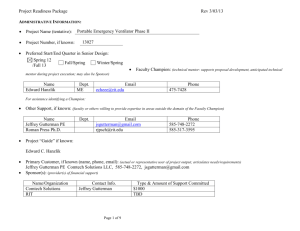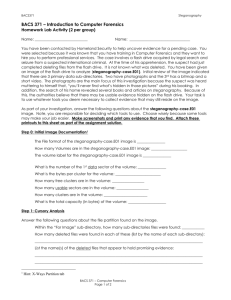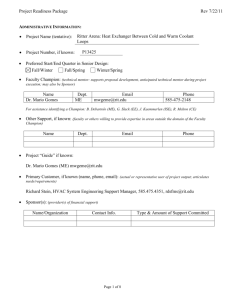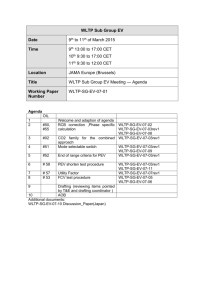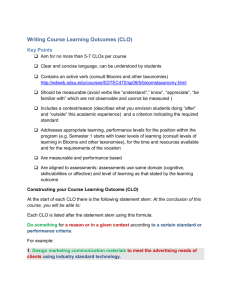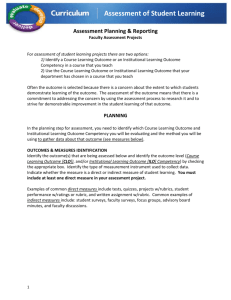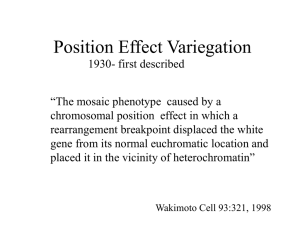Project Readiness Package
advertisement
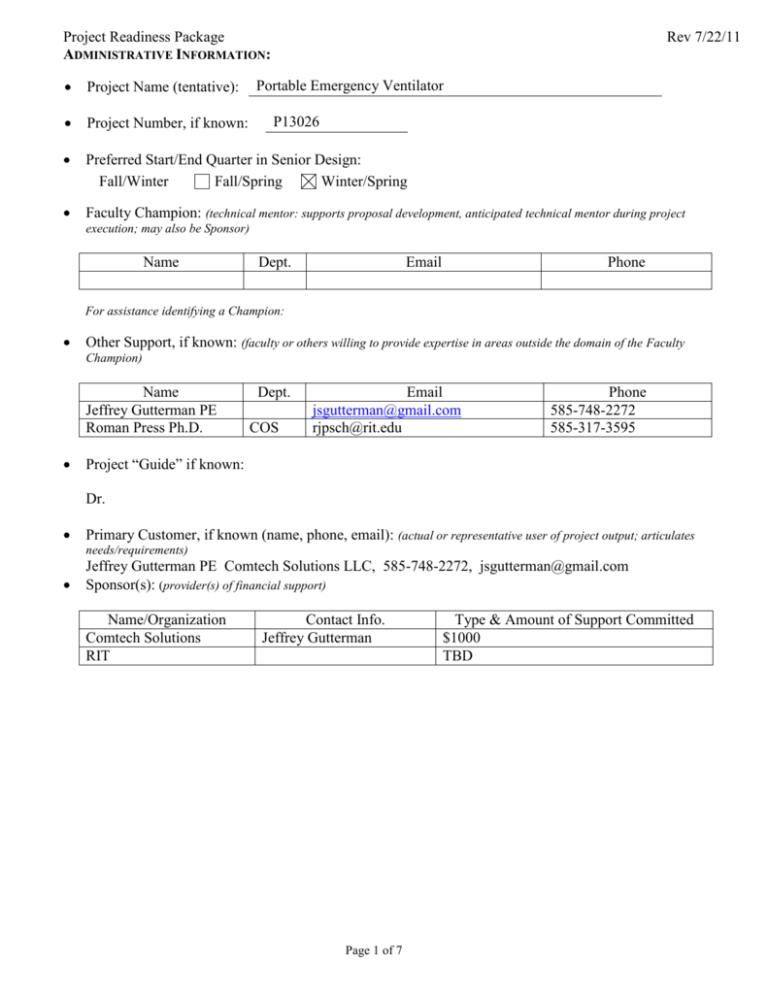
Project Readiness Package ADMINISTRATIVE INFORMATION: Rev 7/22/11 Project Name (tentative): Project Number, if known: Preferred Start/End Quarter in Senior Design: Fall/Winter Fall/Spring Winter/Spring Faculty Champion: (technical mentor: supports proposal development, anticipated technical mentor during project Portable Emergency Ventilator P13026 execution; may also be Sponsor) Name Dept. Email Phone For assistance identifying a Champion: Other Support, if known: (faculty or others willing to provide expertise in areas outside the domain of the Faculty Champion) Name Jeffrey Gutterman PE Roman Press Ph.D. Dept. COS Email jsgutterman@gmail.com rjpsch@rit.edu Phone 585-748-2272 585-317-3595 Project “Guide” if known: Dr. Primary Customer, if known (name, phone, email): (actual or representative user of project output; articulates needs/requirements) Jeffrey Gutterman PE Comtech Solutions LLC, 585-748-2272, jsgutterman@gmail.com Sponsor(s): (provider(s) of financial support) Name/Organization Comtech Solutions RIT Contact Info. Jeffrey Gutterman Page 1 of 7 Type & Amount of Support Committed $1000 TBD Project Readiness Package PROJECT OVERVIEW: Rev 7/22/11 The PEV (Portable Emergency Ventilator) is a life supporting device which quickly and efficiently provides positive pressure ventilation for a non-breathing patient. It is a contaminant free resuscitator that eliminates mouth-to-mouth procedures while permitting life saving treatment for shock, cardiac arrest, heart attack, drug overdose, drowning, smoke inhalation, and other respiratory trauma. Emergency personnel equipped with the PEV have the opportunity to vastly improve a person’s chance of survival and avoid brain damage. Additionally PEV can be used as patient’s transport ventilator for aviation and ground transportation. Currently the existing PEV utilizes analog circuitry, and the most advanced developments in airflow sensing techniques to produce an innovative, life-saving device. By replacing imprecise mouth-to-mouth resuscitation, it provides clean, filtered air and automatically regulates flow and pressure to suit a victim's critical needs. Additionally, the PEV’s unique “CPR mode” eliminates direct patient-rescuer contact, thereby reducing the chances of transmitting communicable diseases. Working prototypes were built and tested successfully thus enabling to receive FDA “Permission to Market” status. In addition to military applications, the PEV can be effectively used in hospitals, clinics, emergency and security vehicles as well as private homes. The Project is based on US patents entitled Portable Emergency Respirator #5,211,170 and # 5,398,676 authored by Roman Press and Jeff Gutterman and their FDA 510K approval to manufacture and market the device. A full working prototype of the ventilator based on now outdated technology serves as a useful example and inspiration for a revised and updated model. The product has a number of unique features including a CPR mode which allows the machine to work in synch with a person administering CPR and an integral sterilizer to provide clean air without any biological contaminations. The goal of the proposed project is the creation of light weight state-of-the-art digital electronic PEV version. This multidisciplinary project can create a positive RIT image as a new technology developer, and may potentially prove to be financially advantageous to RIT as well. The project may consist of the following components: 1. Market analysis and business model creation 2. Engineering design 3. Packaging 4. Microelectronic dedicated IC design and prototyping 5. Biomedical testing 6. IP analysis DETAILED PROJECT DESCRIPTION: o Customer Needs and Objectives: Customer Need # Importance CN1 1 CN2 1 Description The design of an updated version of the PEV that remains “substantially equivalent” to the design which received FDA 510(k) approval to manufacture and market. . Page 2 of 7 Project Readiness Package Rev 7/22/11 CN3 1 . CN4 CN5 CN6 CN7 CN8 CN9 CN10 CN11 CN12 CN13 CN14 1 1 1 2 1 1 1 2 2 1 1 Portable based on digital electronics, preferably on microprocessor Gives non-visual, non-Braille instructions/feedback CN15 2 CN16 3 Operates for a mimimum of 2 hours without recharging Battery is easy to replace Parts cost <$1000 o Functional Decomposition: Pneumatic Interface with patient Pump Power Source Controller Control Panel Power interface Product Specification Control Parameters Power Modes of operation: On/Off 1) Common mode (Automatic) 2) Air Assist 3) Manual 4) CPR Page 3 of 7 Project Readiness Package Volume Control Breathing Rate Pick Flow Air Assist Sensitivity High Pressure Alarm 0.2 to1.2 liters 4 to 15 BPM 15 to 60 liter/min 0.5 to1.5 cm H2O 10 to 70 cm H2O Displays and AlarmsPower On Elapsed Time Breath Per Minutes Liters per Breath CPR Counter High Pressure Low Battery Light Display Display Display Display Tone/Light Tone/Light Electrical InputDC Input DC Internal Battery 6 to 16 Volts 12 V DC Additional FeaturesPEEP Elapsed Time Meter Pump Life O2/Air Mixer Secondary Pressure Relief Timed Backup BPM DimensionsHeight Width Length Weight Rev 7/22/11 0 t0 8000 hours 8,000 hours 21 to 100% O2 75 cm H2O TBD TBD TBD <8.0 Kg Page 4 of 7 Project Readiness Package Rev 7/22/11 Specifications (or Engineering/Functional Requirements): S1 S2 S3 S4 S5 S6 S7 S8 S9 S10 S11 S12 S13 S14 S15 S16 S17 S18 S19 S20 S21 S22 S23 S24 S25 S26 S27 S28 S29 Source Function CN4,8,11,12 CN4,8,11 CN14 CN4 CN9 CN9 CN10 CN1,2 CN1,2,3,7,15 CN5,16 CN1,3,5,7, 16 CN1,3,7,15, 16 CN5,11,12 CN1 CN1,2 System System System System System System System System System System System CN1 CN1 CN11,12 CN3 CH4,12,13 CN6,7,8,10 CN6,7 CN6,7 CN7 CN8 CN3,6,9 CN3,8 System System System System System System System System System System System System System System Specification (metric) Size Unit of Measure inches System System System System Page 5 of 7 Marginal Value Ideal Value <= 4x2x1 Comments/Status Project Readiness Package Rev 7/22/11 Constraints: o Low weigh and physical dimensions o Simplicity of operation o Low cost o Project Deliverables: Expected output, what will be “delivered” – be as specific and thorough as possible. o Fully operational prototype o Design documentation o Operating Instruction o Competitive Analysis Results o FMA&E o Market Analysis o Budget Estimate: $1000 o Intellectual Property (IP) considerations: o As a privately funded project, any IP generated as a result of this project have to discussed with RIT IP professionals o Other Information: Describe potential benefits and liabilities, known project risks, etc. o The device has the potential to save lives. o Medical expenses for rehabilitation can be reduced. o New tool for first responders, emergency medical technicians, public facilities and hospitals. o Continuation Project Information, if appropriate: Include prior project(s) information, and how prior project(s) relate to the proposed project. o o o o Prior project information is attached. Proposed project with updated digital design creates new market niche due to increased portability Testing shock/vibration, corrosion, durability Testing at Strong Memorial Hospital and/or other health organization STUDENT STAFFING: Anticipated Staffing Levels by Discipline: Discipline How Many? Anticipated Skills Needed EE1: Sensor search, analog to digital and digital circuit interface, power budget analysis, pump power system design, device characterization EE 3 EE2: Basic analog circuit design to include voltage and current sense circuitry, battery selection, on-board power source utilization, regulation circuitry, and analog to digital and digital circuit interface design ME 2 ME1:Analysis and ergonomics (with ISE)design of enclosure, based on Page 6 of 7 Project Readiness Package Rev 7/22/11 Solid Work (manufacturing enclosure is acceptable), cables & connectors, heat dissipation, user interface components selection, pump selection CE 1 CE1: Digital Signal Processor/Microcontroller Unit selection, programming, algorithm implementation, memory allocation, PCB layout, DSP/MCU development board interface and usage, troubleshooting Biomedical analysis and test to specification parameters Market analysis ISE 1 ISE1: Ergonomics, usability and human interface, packaging for transportation, maintenance and manufacturing OTHER RESOURCES ANTICIPATED: Category Resourc e Availab le? Description Faculty EE, CE consultants? Environment MSD Design Center EE Senior Design lab Machine Shop & Brinkman lab Equipment Emulation board for Materials Electronic/electrical components, mechanical components, interface devices interface team documentation Other team documentation Prepared by: Date: Page 7 of 7 10/2012
